| Lotus Elise |
|---|
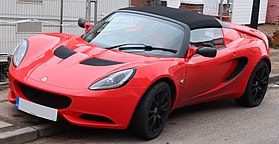
Lotus Elise S Club Racer (Series 3)
|
| Overview |
|---|
| Manufacturer | Lotus Cars |
|---|
| Production | 1996–present |
|---|
| Assembly | Hethel, Norfolk, England
Shah Alam, Malaysia
(Series 1, 1997–2000) |
|---|
| Body and chassis |
|---|
| Class | Sports car |
|---|
| Body style | 2-door roadster |
|---|
| Layout | Transverse mid-engine, rear-wheel-drive |
|---|
| Chronology |
|---|
| Predecessor | Lotus Elan |
|---|
The Lotus Elise is a two-seat, rear-wheel drive, mid-engined roadster conceived in early 1994 and released in September 1996 by the British manufacturer Lotus Cars. The series 1 Elise had a hand-finished fibreglass body shell atop its bonded extruded aluminium chassis that provided a rigid platform for the suspension, while keeping weight and production costs to a minimum. It is capable of speeds up to 240 km/h (150 mph). The Elise was named after Elisa, the granddaughter of Romano Artioli who was chairman ofLotus and Bugatti at the time of the car's launch.
Series 1
| Series 1 |
|---|
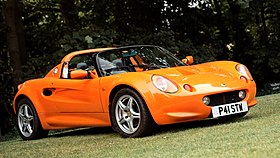 |
| Overview |
|---|
| Production | 1996–2001 |
|---|
| Designer | Julian Thomson |
|---|
| Body and chassis |
|---|
| Related | Lotus 340R
Vauxhall VX220/Opel Speedster
Lotus Elise GT1 |
|---|
| Powertrain |
|---|
| Engine | 1.8 L Rover K-series I4 |
|---|
| Transmission | 5-speed manual |
|---|
| Dimensions |
|---|
| Wheelbase | 2,300 mm (90.6 in) |
|---|
| Length | 3,726 mm (146.7 in) |
|---|
| Width | 1,719 mm (67.7 in) |
|---|
| Height | 1,202 mm (47.3 in) |
|---|
| Kerb weight | 725 kg (1,598.4 lb) ~ 755 kg (1,664 lb) |
|---|
The 1996 Lotus Elise weighed 725 kg (1,598 lb). Because of this low weight, it was able to accelerate 0-60 mph (97 km/h) in 5.8 seconds despite its relatively low power output of 118 bhp (88 kW; 120 PS). Braking and fuel consumption are also improved by the car's reduced weight. Cornering is helped by a low center of gravity height of 470mm (18½").
Series 1 was designed by Julian Thomson, then head of design at Lotus, and Richard Rackham, Lotus's chief engineer.
Besides the standard higher-performance variants listed below, Lotus also released some limited edition models such as Sport 135 (1998/9) with approx 145 bhp (108 kW; 147 PS), Sport 160 (2000) with 150–160 bhp (112–119 kW; 152–162 PS), and Sport 190 (190 bhp (142 kW; 193 PS)). These were more competent on track with sports suspension, wheels and tyres, seats according to model. There were other special editions such as the 50th Anniversary Edition (green/gold) celebrating 50 years of Lotus cars, the Type 49 ("Gold Leaf" red and white two-tone), and Type 79 ("JPS" black/gold) which refers to its successful Grand Prix car type numbers.
The Series 1 Lotus Elise 80 was briefly assembled on a dedicated assembly line at Proton's Shah Alam factory between 1997 and 2000. The Malaysian-assembled Elise costs less than its British-built counterpart as it was manufactured with more Malaysian-sourced components. The Malaysian-assembled Elise was also exported to regional markets, including Japan, Hong Kong, Australia and New Zealand. However, parent company Proton had been severely affected by the 1997 Asian financial crisis, which brought an early end to the Malaysian assembly of the Lotus Elise in late 2000, only three years after it commenced and with an estimated 150 units sold. The Proton-assembled Elises were assigned the code 'B' in the eleventh VIN position, while the original Hethel-built units were stamped with the code 'H'.
111S
A faster edition called the 111S, named after the Lotus type-number of the Elise (Type 111), was introduced in early 1999 and had the 1.8 Rover K-Series engine also used in the Rover MGF. It featured a VVC system providing continuously variable lift and duration on the intake valves only. This technology, producing a flatter torque curve from lower down the rev range and a declared 143 bhp (107 kW; 145 PS). A small but useful improvement over the standard 16 valve Rover 1.8 L K-series 118 bhp (88 kW; 120 PS) inline-four unit. Fitted with a closer ratio manual gearbox and lower ratio final drive the acceleration was improved. Minor changes include more padding in the seats, headlamp covers, rear spoiler, cross drilled brake discs, alloy window winders and a six-spoke wheels. The rear wheels being slightly wider than before necessitated the fitting of "spats" on the back of the rear wheel arches to comply with EU regulations. The 111s was also fitted with a "chipcutter" front grille.
340R
In 2000, the 340R limited edition model, based on a Series 1 Elise was introduced. This roofless car was a special edition, limited to only 340 cars being built. The name 340 originally referred to the 340 bhp/tonne (254 kW/tonne) power-to-weight ratio of the original prototype which had 177 bhp (132 kW; 179 PS) while weighing just 500 kg (1,100 lb). However, in production models the 340 refers to the number of cars built. The final production versions weighed 701 kg (1,545 lb) and had a power-to-weight ratio of (269 bhp/tonne). A "Track Pack" was created that upped power to 192 bhp (143 kW; 195 PS) and weighed only 571 kg (1,259 lb).
Exige
In 2000, Lotus introduced the Exige — a hardtop version of the Elise with the 177 bhp (132 kW; 179 PS) engine from the 340R; as well as different front and rear body "clamshells", larger wheels, and a rear wing. Many models received an upgrade to 190 bhp (142 kW; 193 PS) with better driveability due to changes to ECU and cam timing.
Series 2
| Series 2 |
|---|
 |
| Overview |
|---|
| Production | 2001–2011 |
|---|
| Body and chassis |
|---|
| Related | Lotus Exige
Opel Speedster/Vauxhall VX220
Lotus 2-Eleven
Lotus Europa S
Tesla Roadster
Hennessey Venom GT |
|---|
| Powertrain |
|---|
| Engine | 1.8 L Rover K-series I4
1.8 L Toyota 1ZZ-FE I4
1.8 L Toyota 2ZZ-GE I4 |
|---|
| Transmission | 5-speed (M5) Honda PG1 manual
5-speed Toyota C56 manual
6-speed Toyota C64 manual |
|---|
| Dimensions |
|---|
| Wheelbase | 2,300 mm (90.6 in) |
|---|
| Length | 3,785 mm (149.0 in) |
|---|
| Width | 1,719 mm (67.7 in) |
|---|
| Height | 2002–07: 1,143 mm (45.0 in)
2008–present: 1,117 mm (44.0 in) |
|---|
| Kerb weight | 860 kg (1,896 lb)
910 kg (2,006 lb) |
|---|
The Series 1 could not be produced beyond the 2000 model production year due to new European crash sustainability regulations, so Lotus needed a development partner to meet the investment requirement for a Series 2 car. General Motors offered to fund the project, in return for a badged and GM-engined version of the car for their European brands, Opel and Vauxhall.
The Series 2 Elise, announced on 9 October 2000, was a redesigned Series 1 using a slightly modified version of the Series 1 chassis to meet the new regulations, and the same K-series engine with a brand new Lotus-developed ECU. The design of the body paid homage to the earlier M250 concept, and was the first Lotus to be designed using a computer.
Both the Series 2 Elise and the Opel Speedster/Vauxhall VX220 were built on the same production line, in a new facility at Hethel. Both cars shared many parts, including the chassis, although they had different drive-trains and power-plants. The VX220 carried the Lotus internal model identification Lotus 116, with the code name Skipton for the launch 2.2N/A version and Tornado for the 2004 introduced 2.0 L Turbo. Fitted with 17 inch over the Elise's 16 inch front wheels, the Vauxhall/Opel version ceased production in late 2005 and was replaced by the Opel GT for February 2007, with no RHD version for the United Kingdom.
Basic S2 models had a naturally aspirated 1,795 cc (1.8 L; 109.5 cu in) Rover K-series engine without VVC rated at 120 bhp (122 PS; 89 kW) @ 5600 rpm and 124 lb⋅ft (168 N⋅m) @ 3500 rpm of torque.
111S
The Series 2 was also available as a 111S model, with the VVC engine Rover technology producing 160 hp (119 kW). The 111S models were discontinued in 2005 in favour of the Toyota powerplant.
It is believed that the switch to a Toyota engine was due to federailising issues with the Rover powerplant in the USA, however this has been largely unproven with little information released from Lotus as to the exact reasons. As of the time of the switch the Rover engine would still have met the standards required of it for use in America.
Two more track-focused models, the 135R and Sport 190, were available with 135 bhp (101 kW; 137 PS) and 192 bhp (143 kW; 195 PS) respectively. These also came with associated handling upgrades such as Lotus Sport Suspension and wider wheels with Yokohama Advan A048 tyres. In certain markets, the 135R was replaced by the "Sport 111", which was similar, apart from sporting the 156 bhp (116 kW; 158 PS) VVC engine in place of the 135 bhp (101 kW; 137 PS) tuned K-series.
111R / Federal Elise
This Series 2 Elise model comes in a European 111R version or a version sold in North America, called the Federal Elise. It is powered by the all-aluminium 189 horsepower (141 kW) 1.8L DOHC Toyota ZZ engine with a Yamaha designed twin-cam head offering variable valve timing on both intake and exhaust valvetrain, and a 6speed manual Toyota C64 gearbox. The Series 2 model is acclaimed as the best version of the Elise to date, with tremendous performance numbers. Many tests show 0–60 miles per hour (97 km/h) in approximately 4.9 seconds, or 4.7 seconds with the Sport Package. The engine management computer is a Lotus programmed unit.
The 2005 Lotus Elise was the first to be sold commercially in the United States, in the summer of 2004. Approval for the Elise, however, required intervention by the National Highway Traffic Safety Administration (NHTSA) which provided a three-year exemption for the car, as it had failed to meet US bumper and headlight regulations. The first-year model suffered from a few flaws, most notably a design flaw in the headlamps that magnified the sun’s light, allowing the inside of the lamp housings to be melted by the sun.
This model was followed up by the 2006 Model Year Elise 111R and SportRacer models. Lotus made a limited edition (50 in the US) version called the Lotus Sport Elise. 2006 models differ from the 2005 models in a few aspects. 2006 models sport LED tail lights, drive by wire (an updated ECU), improved fuel consumption, and more comfortable ProBax seats.
For the 2007 model year Lotus several minor changes were made. The LOTUS decals on the rear of the vehicle, previously flat stickers, were replaced by raised lettering. The headlamp units were sealed. Also, in order to comply with US Federally mandated bumper restrictions, the frontal crash structure was slightly changed and rear bumperettes were added next to the licence plate mount. Approximately 100 2007 model year "launch" cars were shipped to the US without these bumper changes. Also in 2007, the Elise S was released and the 111R renamed Elise R. All Lotus Elise cars manufactured after 1 January 2007 include the new headlights and 2.5 mph (4.0 km/h) bumpers, although they are hidden in the front.
The Elise S is the new base model with a Toyota sourced 1.8 L engine replacing the previous models K series Rover engine. The 2ZZ-GE engine produces 189 bhp (141 kW; 192 PS) at 6,200 rpm (a considerable increase over the 120 bhp or 89 kW or 122 PS of the Rover engine). The inclusion of airbags, ABS brakes, electric windows, and carpet in addition to the new heavier engine has increased the base weight to 860 kg (1,896 lb) (approximately 85 kg or 187 lb higher than the previous S model).
2008 models

2008 Lotus Elise R in Western Australia, Australia.
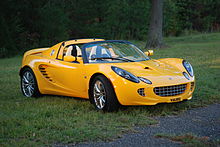
The rare Lotus Elise California Edition near Tuscaloosa, Alabama, United States.
For 2008, there were several additions to the Lotus line-up. There are three versions of the Elise. Lotus continued to provide a naturally aspirated Elise producing 189 hp (141 kW). The second version is the Elise SC sporting a non-intercooled supercharger producing 218 hp (163 kW). 0-60 mph is reduced from 4.9 for the base Elise or 4.7 seconds for the Elise with Sport package to 4.3 seconds for the Elise SC. The NA Elise styling is similar to the prior model years. The Elise SC, however, is distinguishable from the NA version by a rear spoiler identical to the Type 72-D edition spoiler and new wheels. Weight remained a Lotus-claimed 1,987 lb (901 kg); just 3 pounds (1.4 kg) more than the previous year. Prior to the release of the 2008 Elise SC, the limited production California Edition arrived at dealerships. A total of fifty California Edition Elises were produced; 25 in Saffron Yellow and 25 in Ardent Red. The interiors of the Cali's were produced in a light two-tone leather (Biscuit) and the exterior modifications included a silver front grille (a nod to vintage-Ferrari), body-coloured shutter grills on the side inlets and engine cover, enhanced 16-spoke wheels, and a large spoiler that covers the upper-rear deck (72-D style). The Cali's were intended to appeal to "the lifestyle market."
In Europe, there are three models available; the Elise S with a 134 bhp (100 kW; 136 PS), 1.8L Toyota 1ZZ-FE engine and 5 speed manual gearbox (0-60 mph in 5.8 s, top speed 127 mph (204 km/h)); the Elise R with a 189 bhp (141 kW; 192 PS), 1.8 L Toyota 2ZZ-GE engine and 6-speed manual gearbox (0-60 mph in 4.9s, top speed 148 mph (238 km/h)); and the Elise SC with a supercharged non-intercooler 1.8L Toyota 2ZZ-GE engine rated at 217 bhp (220 PS; 162 kW) @ 8000 rpm and 156 lb⋅ft (212 N⋅m) @ 5000 rpm of torque, 6 speed manual gearbox and a spoiler (0-60 mph in 4.3s, top speed 150 mph (240 km/h)).
Several new colour options for 2008 were brought to the marketplace. These include new metallic colours (additional $590) Persian Blue and Liquid Blue; new Lifestyle colour (additional $1200) Isotope Green; new Limited Colour Level (additional $3,300) Candy Red, Ice White, and Burnt Orange; and the new Exclusive Colour Level (additional $5,100) Prism Green and Moonstone Silver. The following colours were discontinued for 2008: Nightfall Blue, Aubergine Purple, Magnetic Blue, Polar Blue, Autumn Gold, Chili Red, and Krypton Green.
Series 3
| Series 3 |
|---|
 |
| Overview |
|---|
| Production | 2011–present |
|---|
| Powertrain |
|---|
| Engine | 1.6 L Toyota 1ZR-FAE I4
1.8 L Toyota 2ZZ-GE I4 (2011 US Models)
1.8 L Toyota 2ZR-FE I4 |
|---|
| Transmission | 6-speed Toyota EC60 manual
6-speed Toyota C64 manual (2011 US Models) |
|---|
| Dimensions |
|---|
| Wheelbase | 2,300 mm (90.6 in) |
|---|
| Length | 3,824 mm (150.6 in) |
|---|
| Width | 1,719 mm (67.7 in) |
|---|
| Height | 1,117 mm (44.0 in) |
|---|
| Kerb weight | 866 kg (1,909 lb)
914 kg (2,015 lb) |
|---|
In February 2010, Lotus unveiled a facelifted version of the second generation Elise. The new headlights are now single units; triangular in shape they are somewhat larger than the earlier lights. The cheapest version in Europe now has a 1.6 litre engine to comply with Euro 5 emissions, with the same power output as the earlier 1.8 136 PS (100 kW; 134 hp). The 1.8 litre Elise comes standard with a Magnuson R900 supercharger making 220 PS (162 kW; 217 hp).
US Model
The 2011 model was the last offered for street legal sale in the United States when the waiver from the United States Government's National Highway Traffic Safety Administration (NHTSA) for Lotus to build and sell cars in the US without smart airbags expired in August 2011. It was also the only Elise to use the Toyota 2ZZ-GE engine in the 2011 model year.
Cup 250
At the 2016 Geneva Motor Show Lotus revealed the high performance version of the Elise called the Cup 250. The Cup 250 is a more track focused and hardcore version of the standard Elise. It has the following specifications according to Lotus:
- Engine: 1.8 litre supercharged Toyota 2ZR-FE Inline-4
- Transmission: 6-speed Toyota EC60 manual with sport ratios
- Power: 243 bhp at 7200RPM
- Torque: 250 Nm at 5500RPM
- Acceleration: 0-60 mph in 3.9 seconds
- Top speed: 154 mph
- Weight: 884 kg (dry weight)
- Downforce: 125 kg at 140 mph
Cup 260
In October 2017, Lotus unveiled a hardcore version of the Elise called the Elise cup 260. It is inspired by the two hardcore variants of the Evora and Exige line up, the sport 380 and the GT430 respectively. It features the double taillight units and rear wing from the Exige Sport 380 and the Lotus 3-eleven respectively. Power has also been uprated and is now 250 hp (186 kW; 253 PS) thanks to a revised supercharger. Other changes include increased top speed, acceleration, low weight and high downforce due to added aero elements. The Elise Cup 260 has the following specifications according to Lotus:
- Engine: 1.8 litre supercharged Toyota 2ZR-FE Inline-4
- Transmission: 6-speed Toyota EC60 manual with sport ratios
- Power: 250 bhp at 7200RPM
- Torque: 265 Nm at 5500RPM
- Acceleration: 0-60 mph in 3.8 seconds
- Top speed: 151 mph
- Weight: 862 kg (dry weight)
- Downforce: 180 kg at 151 mph
Elise Sprint
In March 2017, Lotus announced the special edition 'Sprint' models of the Elise. For the Elise Sprint, Lotus used several weight-saving techniques to cut the car's weight down to 789 kg (1,739 lb). The Sprint can be had in either a 1.6-litre naturally aspirated engine, or a 1.8-litre supercharged engine, available for the Sprint 220 version. The former has a 0-60 mph time of 5.9 seconds, while the Sprint 220 can hit 0-60 mph in only 4.1 seconds.
Elise Concept

Third generation Elise Concept at the 2010 Paris Motor Show.
The series 3 Lotus Elise first appeared as a design study alongside the Lotus Esprit concept at the 2010 Paris Motor Show as the "Lotus Elise Concept" in the autumn of that year, and was set to be launched within the next couple of years. The car was heavier than the production model of that time, and had a considerably more powerful 2.0-litre inline-4 engine.The production model was then unveiled with many changes, including the downsizing of the engine to 1.6 litre and 1.8 litre (supercharged) and a different design with little cues taken from the concept.
Special editions
- Sport 190
- Sport 160
- Sport 135R
- Lotus Sport 111 (Track based option for Australia, Hong Kong, Japan & Singapore)
- Type 23
- 50th Anniversary Edition
- 60th Anniversary Edition
- Jim Clark Type 25
- Type 25
- Type 49
- Type 72
- Type 79
- Type 99T
- Sports Racer
- Race Tech
- Club Racer
- California Edition
- Purist Edition
- Final Edition
- Roger Becker SC
Exige
The Series 2 Exige comes with the same high revving Toyota 1.8L engine and six speed gearbox as the Elise 111R, replacing the Rover K-series engine of the previous Exige.
The Series 2 Exige has been followed by the limited-edition Lotus Sport Exige 240R, incorporating a Lotus-developed supercharger atop the Lotus engine. The US Federalised version with the supercharger fitted is known as the Exige S 240.
Zytek Lotus Elise
The Zytek Lotus Elise is an electric sports car that was jointly produced by Lotus and Zytek from 1998 until it was discontinued in 2003.
Its 70 kilograms (150 lb) extruded aluminium space frame and lightweight composite body shell are factors in its low kerb weight of 875 kilograms (1,929 lb). 250 nickel-cadmium batteries provide 300 volts (at full charge) to two Zytek oil-cooled brushless DC motors, which deliver a total power of 150 kW (200 hp) and torque of 100 N⋅m (74 lb⋅ft). These motors are each mated to a single-speed, fixed ratio transmission with an aluminium gear. Its acceleration time from 30 to 70 miles per hour (48 to 113 km/h) is 5 seconds, and from 0 to 90 miles per hour (140 km/h), 11.2 seconds. The car is governor-limited to 90 miles per hour (140 km/h) to conserve charge. The range per charge is typically 100 to 120 miles (160 to 190 km) and the car can be re-charged within an hour.
There is an example of the Zytek Elise on display at the Heritage Motor Centre.
Other cars sharing the Elise platform
- Hennessey Venom GT
- Lotus 2-Eleven
- Lotus 340R
- Lotus Circuit Car
- Lotus Elise GT1
- Lotus Europa S
- Lotus Motorsport Elise
- Lotus Sport Exige 300RR
- Melkus RS 2000
- Opel Speedster/Vauxhall VX220/Opel Eco-Speedster Concept
- Rinspeed sQuba
- Tesla Roadster (2008)
- PG Elektrus
- Detroit Electric SP.01
Awards and recognition
The Elise has received critical acclaim for its performance and driving experience, including Best Driver's Car 2001 (Autocar), Car of the Year 2003 (UK Horizons TV), and Best Sportscar 2004 (BBC Top Gear Magazine).
Gallery
-
-
Lotus Elise 111S (Series 1) at the Thatcham Classic Car Show in 2009
-
Interior of a Lotus Elise
-
A Lotus Elise drives on Interstate 4 in Central Florida
US "Federal Elise" configuration of a standard Lotus Elise on display in Indiana
Elise SC premiere at the 2007 Tokyo Motor Show
-








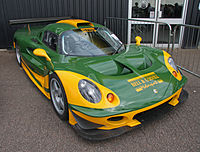
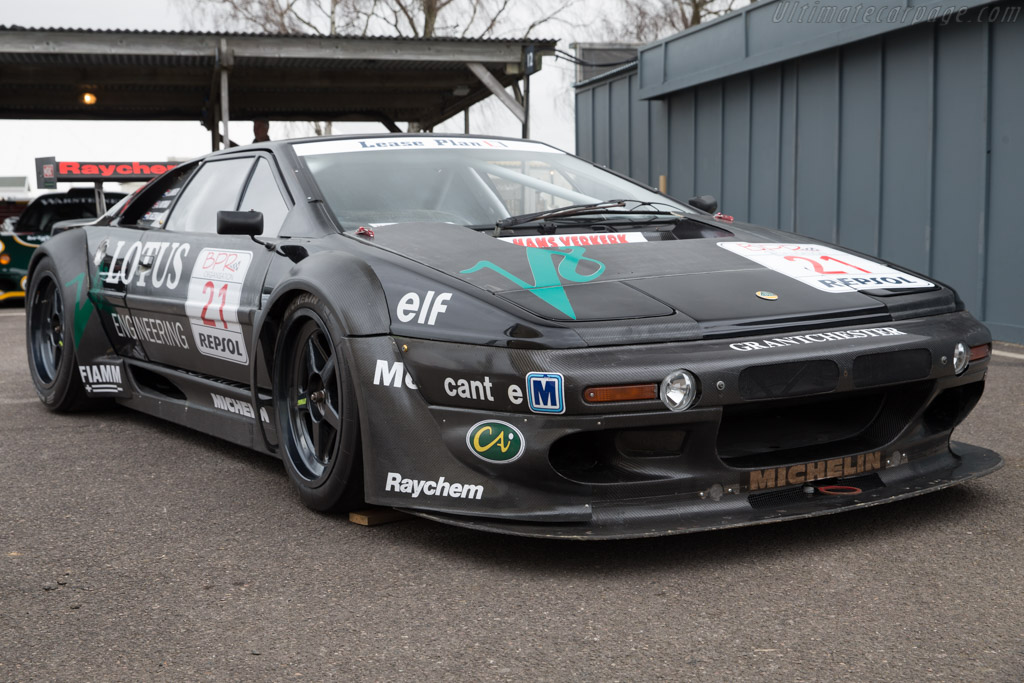





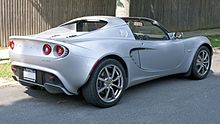



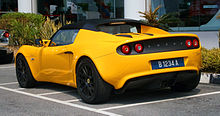














![Validate my RSS feed [Valid RSS]](valid-rss-rogers.png)














































































